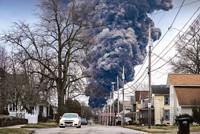Advertisement
Grab your lab coat. Let's get started
Welcome!
Welcome!
Create an account below to get 6 C&EN articles per month, receive newsletters and more - all free.
It seems this is your first time logging in online. Please enter the following information to continue.
As an ACS member you automatically get access to this site. All we need is few more details to create your reading experience.
Not you? Sign in with a different account.
Not you? Sign in with a different account.
ERROR 1
ERROR 1
ERROR 2
ERROR 2
ERROR 2
ERROR 2
ERROR 2
Password and Confirm password must match.
If you have an ACS member number, please enter it here so we can link this account to your membership. (optional)
ERROR 2
ACS values your privacy. By submitting your information, you are gaining access to C&EN and subscribing to our weekly newsletter. We use the information you provide to make your reading experience better, and we will never sell your data to third party members.
Environment
Newscripts
Amazing Grease, Feel the Chemistry, Noel, Neighbors Don't Want the Shaft
December 19, 2005
| A version of this story appeared in
Volume 83, Issue 51
Amazing grease
Combining vegetable oils with methanol in a transesterification reaction yields a fatty acid methyl ester, known as biodiesel used to fuel cars and trucks, and glycerin. C&EN reader Robert E. Wallace asks, Why bother?
The 82-year-old retired metallurgical engineer and Saratoga, Calif., resident says he just adds straight vegetable oil to his 1978 Mercedes diesel sedan. Instead of stopping at local fueling stations, he swings by local restaurants and picks up their used frying oil at no charge. Once back at his own garage, he lets the containers sit for a week or so to let the sediment settle. Then he pours it into his tank, and off he goes.
If not removed from the vegetable oil, glycerin would thicken the alternative fuel and clog fuel lines in cold areas. Fortunately for Wallace, Saratoga's climate is warm year-round. However, cold temperatures can't discourage the most die-hard vegetable oil fuel enthusiasts.
On Long Island, N.Y., where freezing winter temperatures are the rule and not the exception, software engineer Anthony Gianakis fuels his 1998 Volkswagen Jetta diesel with the detritus of America's love affair with fried fast foods, according to an article in the Nov. 9 issue of Newsday. He starts up with regular diesel and then turns a switch directing used cooking oil from a heated tank in his car to his engine.
With a few modifications, anyone with a diesel car can join the club. Companies such as Greasecar Vegetable Fuel Systems, Florence, Mass., sell conversion kits for about $800. You can tell the switchover has taken place when the tailpipe stops spewing black exhaust and starts smelling like french fries-or should it be "freedom fries"?
Feel the chemistry
Avid newscripts reader Neil Gussman of Lancaster, Pa., called to warn ACS members that if they mistype the address for the American Chemical Society Web portal, they may just get more than they bargained for. The ACS Web portal is chemistry.org. However, an online dating service uses the Web address chemistry.com.
A matchmaking service of match.com, the chemistry.com website declares it is "the first site to understand the importance of chemistry." It also advises those looking for a soul mate that the service offers those who sign up a chance at "an enduring relationship that starts with the spark of chemistry." And in case Web visitors don't get the message, the site quotes Debbie, who testifies, "Once you start talking, if it's 'right,' you can feel the chemistry growing stronger and stronger."
Noel
The Nov. 21 issue of C&EN contained a classified ad at the top of page 58 with an unusual seasonal requirement. Amgen, it seems, "has an opportunity for a Senior Associate to be responsible for the synthesis of noel molecules."
Mark L. J. Reimer, senior director, metabolism resources, at MSD Pharma Services, wrote Newscripts to say the novel request "appears to be a very opportune job posting, considering we are entering the Christmas season."
Neighbors don't want the SHAFT
Neighbors are so upset with Albert Swank Jr.'s plans to install a nuclear particle accelerator in his home in Alaska that they have taken to calling it SHAFT-Swank's high-energy accelerator for tomography.
"We know that Anchorage is gonna get the SHAFT, but we just don't know when," says Alan Tesche, an assemblyman for the city of Anchorage who represents the area where Swank and his accelerator would reside.
Advertisement
Johns Hopkins University agreed to donate the 6-foot-tall by 8-foot-wide cyclotron to Swank, who plans to use it to supply radioactive substances that can be injected into patients undergoing positron emission tomography scans. Swank, a civil engineer who lost his father to cancer, says his community needs the medical resource.
According to a Dec. 1 article on wired.com, Tesche says people fear that a particle accelerator could expose nearby residents to radiation leaks, and they think that the large amount of electricity it draws could drain power in the neighborhood. The Anchorage Assembly plans to hold an emergency hearing on Dec. 20 to determine if Swank will get a permit to install the device.
This week's column was written by Marc Reisch. Please send comments and suggestions to newscripts@acs.org.





Join the conversation
Contact the reporter
Submit a Letter to the Editor for publication
Engage with us on Twitter